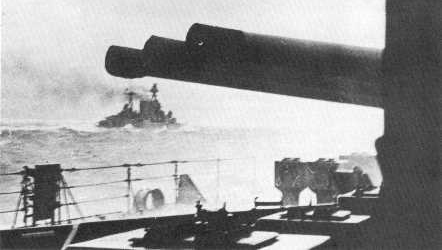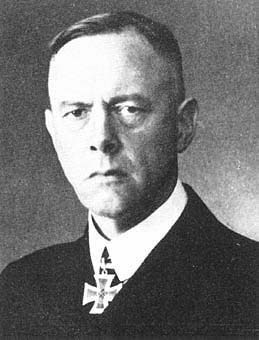I Was There! - I Saw One Vast Explosion - The Hood Had Gone
The War Illustrated, Volume 4, No. 94, Page 621-622, June 20, 1941.
The end of the 'mighty Hood' was described as an almost unbelievable nightmare by Reuter's special correspondent, who was on the bridge of one of our warships when the Hood went down with her guns still firing.
The "Battle of the Giants" was the climax to a chase by Hood and Prince of Wales with their accompanying destroyers at top speed to prevent the Bismarck breaking out into the Atlantic to attack convoys. The pursuit began off Iceland, and continued hour after hour in the eerie half-light of the Arctic night.
 H.M.S. Hood going into action in Denmark Strait: a last photograph of the battleship seen beyond the guns of H.M.S. Prince of Wales. Photo, Wright & Logan.
H.M.S. Hood going into action in Denmark Strait: a last photograph of the battleship seen beyond the guns of H.M.S. Prince of Wales. Photo, Wright & Logan.
The cruisers Suffolk and Norfolk, which had been shadowing the Bismarck since she left Bergen, kept Hood and Prince of Wales and others informed of her movements, and so helped them find their quarry.
It did not get dark at any time that night. Until two or three o'clock it was nearly as light as day; then for the next few hours a leaden greyness settled down and it was like a dull winter's afternoon in Britain. It was expected to contact the Bismarck at about 2 a.m., but at the last moment she altered course. For four more hours Hood and Prince of Wales continued on a course. roughly parallel to the enemy's. Blinding snowstorms lashed the black sea, and at times visibility fell to a few yards. Then, as if Nature were taking a hand, this curtain suddenly lifted. There was the dark sea, and there in the sombre, murky light of dawn appeared two black specks on the horizon – the Bismarck and her accompanying cruiser.
For some minutes our ships steamed on towards the Germans to shorten the range. They, too, turned in towards their pursuers, so the world's biggest warships were thundering towards one another at a combined speed of probably over 60 miles an hour. The tension of waiting for the battle to begin became acute.
"Open fire" was ordered by signal, and almost simultaneously with the order orange-gold flame belched with a roar from Hood's forward guns. Within three seconds puffs of black smoke shot out from the Bismarck; she had also opened up.
Prince of Wales's guns then began firing. Dense clouds of yellow cordite smoke enveloped her bridge, momentarily blotting out the view. To the left Hood, two or three hundred yards away, was still surging forward on a parallel course. Fountains of water shot up in her wake – the first about a hundred yards astern, the second fifty. Hood thundered on, leaving the subsiding water rapidly behind. The shell or shells appeared to fall just ahead of one of her after 15-in. gun turrets, and a large fire broke out, with thick black smoke. Hood continued to fire and to race forward.
What happened next was a sickening sight. There was a terrific explosion, and the whole of the vast ship was enveloped in a flash of flame and smoke which rose high into the air in the shape of a giant mushroom. Sections of funnels, masts and other parts were hurled hundreds of feet into the sky, some falling on the ship.
Hood's bow tilted vertically into the air, and three or four minutes after she was hit all that remained, apart from bits of wreckage, was a flicker of flame and smoke on the water's surface.
A destroyer was diverted to rescue work, and picked up three of the ship's company – two seamen and a midshipman.
All this time Prince of Wales had continued firing at the Bismarck, and more than once spurts of water showed that she was straddled. Again the Bismarck's shells fell near the Prince of Wales, but no serious damage had been done. Then the Bismarck turned away, but only to be pursued all that day and night and next day over the Atlantic at high speed.
Previous and next article from The Bismarck and The Hood
I Was There! - How Our Catalina Shadowed the Bismarck
American-built Catalina flying-boats of the R.A.F. Coastal Command played a vital part in the tracking down of the ill-fated Bismarck. On occasion they encountered heavy fire from the battleship, as t
'Closer, Get Closer Yet to the Bismarck!'
From 8.30 on the evening of May 26 until it was all over at about noon the next day – until, that is, the Bismarck had been fought to a finish and sent to the bottom – the officer whose story we g
Previous and next article from I Was There!
I Was There! - How Our Catalina Shadowed the Bismarck
American-built Catalina flying-boats of the R.A.F. Coastal Command played a vital part in the tracking down of the ill-fated Bismarck. On occasion they encountered heavy fire from the battleship, as t
I Was There! - We Helped in the Sinking of the Bismarck
The terrible punishment which the Bismarck withstood before she was finally torpedoed and the rescue of a hundred or so survivors from the great German warship are described by British naval officers
Index
Previous article
I Was There! - How Our Catalina Shadowed the Bismarck
American-built Catalina flying-boats of the R.A.F. Coastal Command played a vital part in the tracking down of the ill-fated Bismarck. On occasion they encountered heavy fire from the battleship, as t
Next article
'Closer, Get Closer Yet to the Bismarck!'
From 8.30 on the evening of May 26 until it was all over at about noon the next day – until, that is, the Bismarck had been fought to a finish and sent to the bottom – the officer whose story we g




